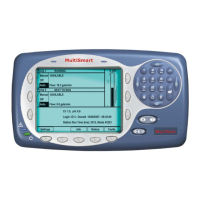MultiSmart Installation & Operation Manual
24.3.1.14 MonthlyTimer
This function is like the DailyTimer function, except that it can be used to trigger an output at the same time
each month.
24.3.1.15 NextPumpRunning
This function block returns whether a specified pump is currently running. It receives a pump number
(1,2,3…) as an input, and returns a Boolean result specifying whether the selected pump is running.
24.3.1.16 NextPumpToRun
This function returns the pump number (1,2,3…) of the next pump which will be run. This takes into account
any pump alternation scheme defined in the unit.
24.3.1.17 NumRunningPumps
This function returns the number of currently running pumps which are managed by the MultiSmart.
24.3.1.18 PumpAuto
This function block can be used to place a pump into AUTO mode. It receives a pump number as an input,
as well as a Boolean variable which defines whether the function block should be activated. It returns a
Boolean result, indicating whether the operation was successful.
24.3.1.19 PumpHoldout
As of MultiSmart version 2.0.0, a new Holdout fault has been defined. This fault can be used to hold out a
pump without “faulting” it. (i.e. There is to fault indication on the unit). The PumpHoldout function block can
be used to activate this condition. However, its operation depends upon the unit being configured
appropriately. This function block actually writes to the source of the PumpHoldout fault. If the source is not
defined, then this action will have no effect. As well, if the source is defined to be a digital input, then the
value of the digital input will override any attempt made by this function block to modify the source.
Therefore, if use of this function block is desired, then the source of the PumpHoldout fault should be set to
a digital tag not defined by a physical input. The tags defined under Isagraf5.Values are most
appropriate for this purpose. In order to do this, first go to the Advanced screen. Then navigate to:
FaultModule->Pump->Pump_n->Pump Holdout->Status
Highlight Source and press the middle left button. Then navigate to Isagraf5.Values and select one of
the digital tags (e.g. Digital01). Then press OK.
The PumpHoldout function block can then be used to hold out the pump. The function block receives a
pump number as an input, as well as Boolean variable which defines whether activate or clear the holdout
condition. It returns a Boolean result, indicating whether the operation was successful.
24.3.1.20 PumpManual
This function block can be used to place a pump into MANUAL mode. It receives a pump number as an
input, as well as a Boolean variable which defines whether the function block should be activated. It returns a
Boolean result, indicating whether the operation was successful.
24.3.1.21 PumpOff
This function block can be used to place a pump into OFF mode. It receives a pump number as an input, as
well as a Boolean variable which defines whether the function block should be activated. It returns a Boolean
result, indicating whether the operation was successful.
24.3.1.22 Ramp
This function block can be used to generate a ramp output. It receives four values as inputs. They are the
SVAL- Starting Value (DINT), EVAL – Ending Value (DINT), STIM – Starting Time (TIME) and ETIM –
Ending Time (TIME). It returns a Boolean result ACT, indicating whether the Ramp function is currently
running and DINT output, RES which shows the current value of the ramp output.
Page 208 of 260 MultiSmart_IO_Manual_R20

